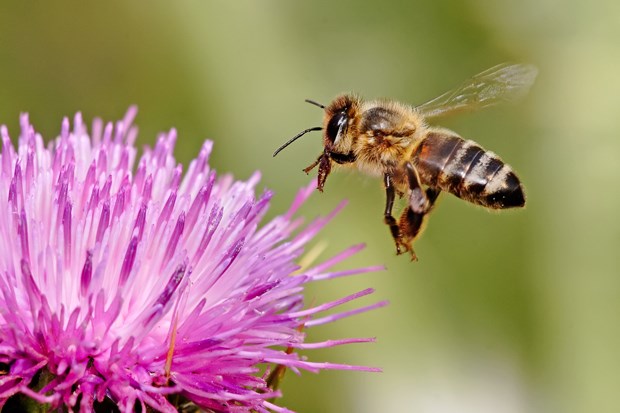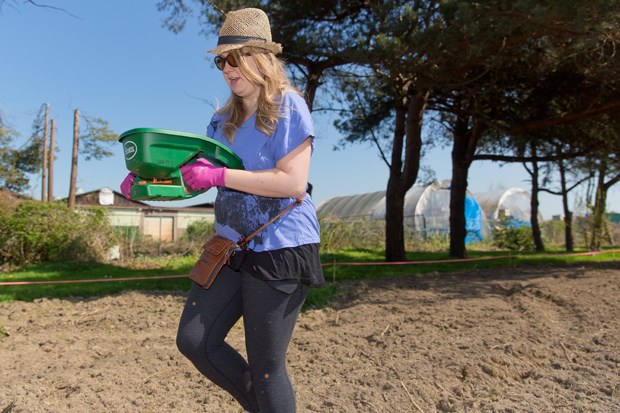The early morning drizzle drips past the high voltage transmission wires overhead, eliciting a noticeable buzzing hum along the narrow greenbelt leading towards Bath Slough.
It’s an easily overlooked 1,000-foot-long by 71-foot-wide BC Hydro right-of-way strip dividing commercial and residential properties in the No 5. and Bridgeport roads area that by summer time will have a natural buzz of its own — the industrious vibration of bees’ wings.
Right now, the mulch trail, grass and sections of recently turned soil isn’t much to look at. But a flurry of seeding activity in recent weeks will soon blossom, transforming it into a colourful pasture of wildflowers that will serve as a vital source of food for the wild pollinators who find it.
It’s a vision Cameron Cartiere and a host of volunteers are helping bring to life as the Bath Slough Pollinator Project.
Cartiere, an associate professor, writer and researcher at Emily Carr University of Art and Design who specializes in public art, urban renewal, and sculpture parks was drafted into the project after the City of Richmond sought to help remediate the little-used hydro property that had, over the years, become crowded out by a small forest of pine trees.
When a row of them was removed a short while ago, it brought about an interesting opportunity, said Cartiere.

Originally, the city was talking about having a small pollinator at the east end of the area.
But when Richmond officials became aware of Cartiere’s work on some Vancouver-based projects that used public art as the driver to create pollinator pastures in neglected green belts, the move was on to remediate the entire, 2.6 acre, narrow parcel of land, making it bee-friendly.
“(The larger area) would have much more significance and impact, plus it would be a beautification project which would also be educational,” Cartiere said, adding wild pollinators have significant challenges to their existence, with sustainable food sources a major concern.
The greenway will be seeded in two phases. What has already been put down is a cover crop consisting of sweet alyssum, crimson clover and phacelia.
Combined, they will present long strips of white, red and purple flowers that are good for bees, but will also help stabilize the soil, and fight off weeds.
Once they finish flowering, the plants will be turned into the soil and the next group of seeds — native wildflowers — will be planted.
And at either end of the pasture will be a “bee hotel,” a small, sheltered structure that will entice wild pollinators to set up home.
Feeding the bees
With a community such as Richmond that still has a large portion of active farmland, one may think it would serve as an ideal haven for wild pollinators.
But talk to Brian Campbell, a local bee keeper and seed expert at West Coast Seeds who is assisting with the Bath Slough project, and he’ll tell you otherwise.
“We have farmland, but actually the city is much better for bees,” Campbell said. “Blueberries and cranberries, require a lot of fungicides and insecticides which are not bee-friendly at all.
“The residential areas are much friendlier for bees because you’ll find greater diversity of food sources there than in, say, a blueberry patch.”
Variety of food sources for bees is key, said Paul van Westendorp, the provincial government’s apiculture specialist.
“The problem we have in many agricultural areas is monocultural practices,” van Westendorp said, adding part of that is a low tolerance for unmanaged vegetation.
“We like to get rid of weeds,” he said. “We like to control everything.”
The result of that, from a strict ecological perspective, is a decline of biodiversity.
“That’s why it’s so very positive to have something like this (pollinator project) to be happening in Richmond,” he said, adding similar efforts are underway in neighbouring South Delta and on Vancouver Island.
“With them, not only do you create an environment supporting greater bee populations, but by virtue of that you also enhance overall biodiversity,” said van Westendorp. “Many of the plants growing and producing these flowers can set seed properly and feed birds like chickadees who, in turn, eat insects that damage plants like our beloved roses, or whatever.
“The whole process of developing an enhanced biodiversity results when you have an optimum environment for pollinators.”
Van Westendorp also likened a healthy wild pollinator population to a spark plug for the environment.
“The bees are a key component to what a healthy environment is, no question. And having a pasture like what’s being planned in Richmond is a truly qualitative, enhancement of the environment,” he said. “Why have some dull, piece of land that is no real use to anybody. Why not change it into a valuable food source that encourages greater biodiversity.”
Art advances the cause
In an age when public project funds are scarce and political will withers, developing multi-faceted initiatives is growing in popularity.
In terms of the Bath Slough Pollinator Project, it ticks a number of boxes.
“It’s a great way of combining public art, ecology and public engagement directly in the community,” said Lesley Douglas, the City of Richmond’s manager of environmental sustainability.
Part of the creative art will come in the manner in which the second phase of seed planting will be done.
Emily Carr’s Cartiere said that when seen from overhead, the bands of colourful flowers will be shaped to represent the wings of the western bumble bee, one of the pollinator species considered endangered in B.C.

And since the pasture lies directly under the east-west flightpath at YVR, it is hoped to be a welcoming sight for air travellers.
“When it came to designing the seeding of the pasture, it was like creating a canvas with the seeds being the paint,” Cartiere said.
To help foster public interest and help create smaller, home-based versions of the pasture, seeds from the flowers will be harvested and redistributed through the Richmond Seed Bank with students at Emily Carr tasked with designing the seed packets.
“That’s another way to bring art into the process,” Cartiere said.
By mid-September, it’s expected there will be a production of hand-made paper from recycled sources at Richmond City Hall and Emilly Carr which will be infused with flower seeds and then laser cut into the shape of bumble bees.
The paper production will be done as part of a workshop with children, and their efforts will be displayed at the Richmond Art Gallery.
“At the end of the exhibition in January, we will invite the community to come in and let half of the (paper bumble bee) colony ‘swarm.’ People will be able to come into the gallery, take a sheet of paper and plant it...,” Cartiere said.
The remaining paper bees bearing seed will then be sent to Kelowna where an exhibition will be held next summer.



